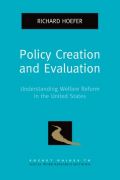
Policy creation and evaluation: understanding welfare reform in the united states
Hoefer, Richard
This pocket guide will be useful to researchers as well as students in advanced social policy courses seeking to understand the two stages of policy-making, to develop policy, to be able to describe the impact of social policy on social problems. Although practitioners do not often identify an explicit focus on social welfare policy, the analysis (what it is) and evaluation (what it does) of policy is basic to social work practice. This unique pocket guide presents a case study on one of the most important domestic policy decisions in thepost-WWII era, the passage of the Personal Responsibility and Work Opportunity Reconciliation Act (PRWORA) of 1996. This law ended welfare as we knew it bycreating the Temporary Assistanceto Needy Families (TANF) program and closing the Aid to Families with Dependent Children program.Examining the law through three decision-making models assists readers in understanding TANF's historical antecedents, its political and power implications, and the way in which it meets social and economic goals. Individual chaptersdemonstrate how programs such as TANF are evaluated and the methods that can be used, such as primarily qualitative, primarily quantitative, and mixed methods evaluation techniques. Illustrating the advantages and disadvantages of each approach for evaluation,Hoefer makes use of the numerous studies undertaken in the thirteen years since welfare reform and its 2006 reauthorization. Part history text, readers will also learn about the details of the TANF legislation creation and evaluation, but will finish with a greater understanding of the policy creationand evaluation processes.This pocket guide will be useful to researchers as well as students in advanced social policy courses seeking to understand the two stages of policy-making, to possibly develop policy, to be able to describe the impact of social policy on social problems. Preface1. Social Policy Creation and EvaluationPart I. Social Policy Creation2. Using the Historical Approach3. Using the Politics and Power Approach4. Using the "Rational Actor" ApproachSummary of the Three ModelsPart II. Social Policy Evaluation5. Using Qualitative Methods to Understand What the Policy DidWith Regina Aguirre, PhD6. Using Quantitative Methods to Understand What the Policy Did7. Using Mixed Methods to Understand What the Policy Did8. Conclusion: Understanding Social Policy Creation and EvaluationGlossaryReferencesIndex
- ISBN: 978-0-19-973519-8
- Editorial: Oxford University
- Encuadernacion: Rústica
- Páginas: 224
- Fecha Publicación: 17/11/2011
- Nº Volúmenes: 1
- Idioma: Inglés
